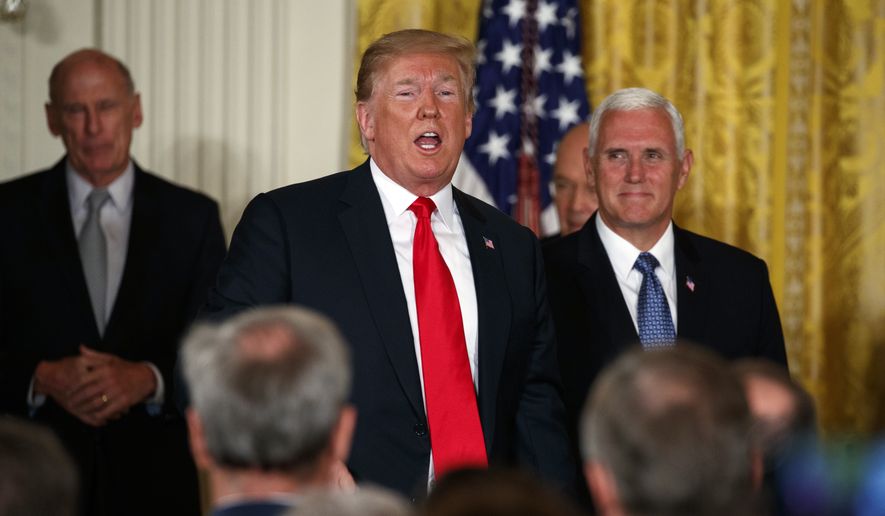President Trump on Monday directed the Pentagon to launch the process for creating a “Space Force” that would extend U.S. military might into the final frontier.
Mr. Trump previously mused about establishing a Space Force but put the idea into action with a direct order to Secretary of Defense James N. Mattis and Joint Chiefs of Staff Chairman Marine Gen. Joseph F. Dunford.
“Very importantly, I’m hereby directing the Department of Defense and Pentagon to immediately begin the process necessary to establish a space force as the sixth branch of the armed forces,” he said. “That’s a big statement.”
Mr. Trump made the surprise order at a meeting of the National Space Council.
“When it comes to defending America, it is not enough to merely have an American presence in space. We must have American dominance in space,” the president said, flanked by Vice President Mike Pence, NASA Administrator Jim Bridenstine and other Cabinet officials.
Currently, U.S. military space operations are managed by Air Force and Navy leadership, focusing largely on surveillance and reconnaissance satellites and intercontinental ballistic missile defense systems. On Monday, Mr. Trump said the new Space Force branch would be independent of the air and sea services, noting the new space branch would be “separate but equal” with the other services.
Aside from military objectives, the new space force would also spearhead new U.S.-led efforts to return to the moon and eventually launch a new exploratory mission to Mars.
“We are going to have the Air Force and we are going to have the Space Force, separate but equal. It is going to be something so important,” said Mr. Trump.
Defense Department spokeswoman Dana White said Pentagon officials immediately began to evaluate the White House’s Space Force proposal.
“We understand the President’s guidance. Our Policy Board will begin working on this issue, which has implications for intelligence operations for the Air Force, Army, Marines and Navy,” Ms. White said in a statement, adding “this will be a deliberate process with a great deal of input from multiple stakeholders” including Congress.
The service branches have yet to issue statements in response to Mr. Trump’s order, and it remains unclear what role NASA would play in the creation of the new space-based military branch.
The move was taken on by the White House in response to reported efforts by Beijing and Moscow to weaponize the space domain. Washington cannot afford to allow “China and Russia and other countries leading us” in space, Mr. Trump said.
The Defense Department’s new National Defense Strategy, released earlier this year, outlined a new national security doctrine for the U.S., shifting focus away from recent counterterrorism operations that have defined America’s wars in Iraq, Afghanistan, Syria and elsewhere for the last several decades, to threats posed by near-peer competitors such as Russia and China.
Mr. Trump hosted the National Space Council to sign a new directive to overhaul space traffic management and space debris tracking.
The White House billed the effort as part of the president agenda to restore U.S. leadership in space.
The new policy aims to clear the way for increased commercial, civil and national security activities in outer space, said Scott N. Pace, executive secretary of the National Space Council.
“Unfettered access and freedom to operate in space are vital U.S. interest. However, the space operating environment is becoming increasingly congested and current space traffic management activities are inadequate to address this rising challenge,” said Mr. Pace.
With an emphasis data sharing initiatives, the administration hopes to tap into commercial space know-how in tackling the challenge of a low-Earth orbit increasingly crowded with communications satellites and space junk.
The Pentagon and NASA track more than 500,000 pieces of space junk circling the Earth, including about 1,730 operating satellites.
The policy followed previous directives in which Mr. Trump renewed a focus on crewed space flights and deep space exploration.
He also previously ordered the Commerce and Transportation departments to cut red tape hampering commercial space activities.
• S.A. Miller can be reached at smiller@washingtontimes.com.
• Carlo Muñoz can be reached at cmunoz@washingtontimes.com.




Please read our comment policy before commenting.